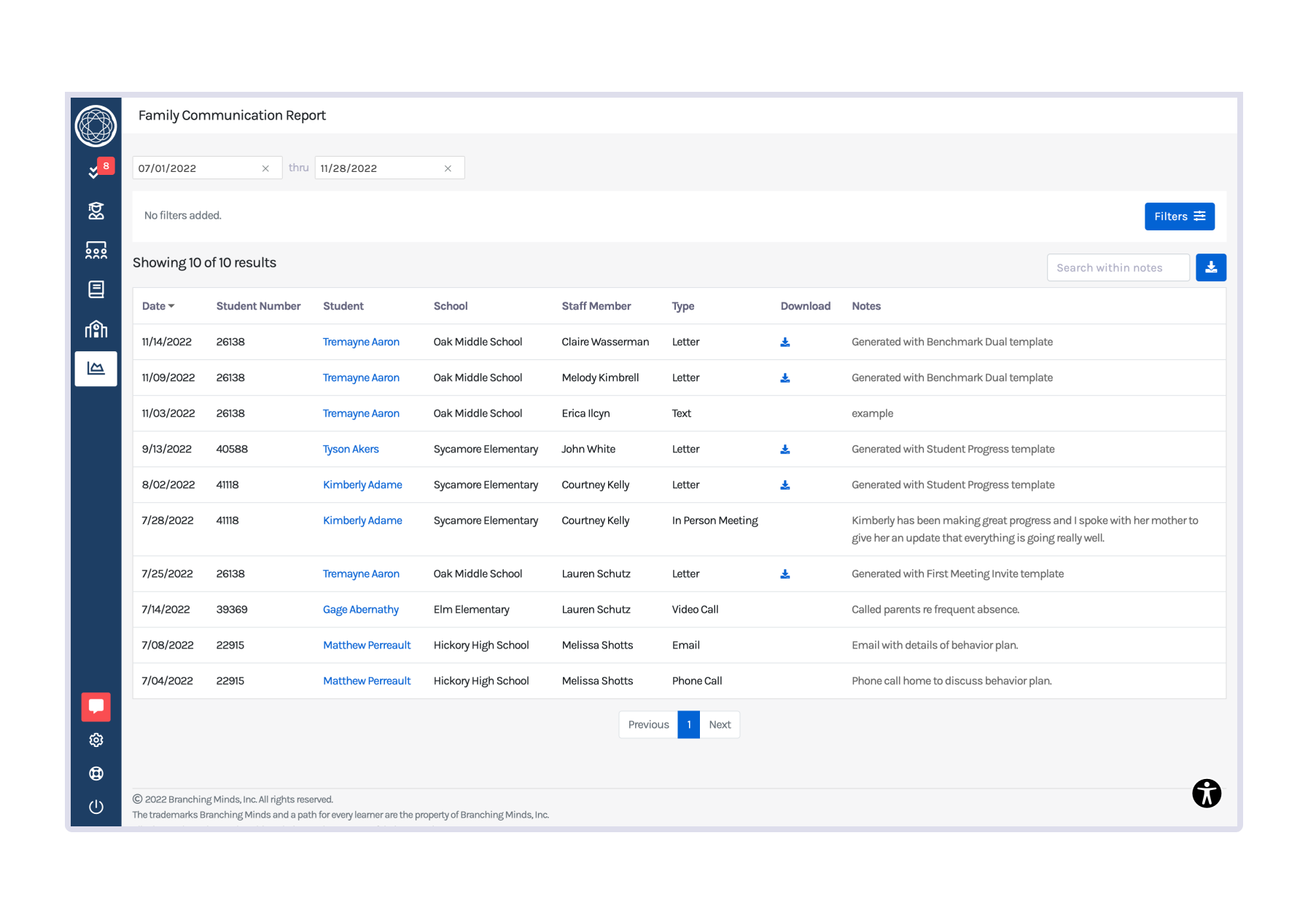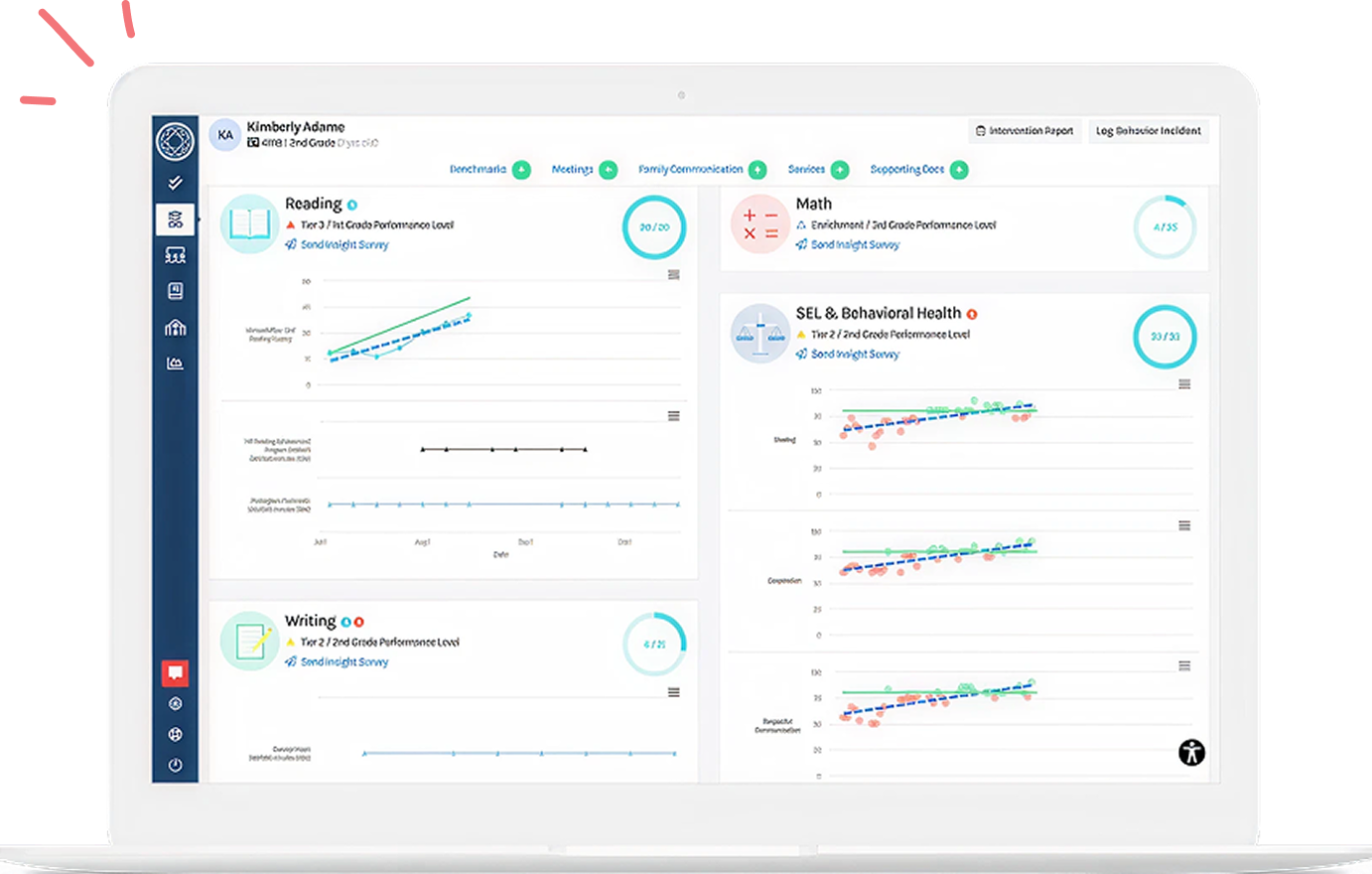Attendance is crucial for student success—after all, they can’t learn if they’re not there. During and after the pandemic, attendance issues have surged, with about 26% of public school students considered chronically absent in 2022-2023, up from 15% pre-pandemic. There’s also been a rise in school refusals linked to mental health struggles.
Addressing attendance should be part of a school’s Multi-Tiered System of Supports (MTSS), which focuses on understanding students’ holistic needs and creating targeted interventions. Educators need insights into attendance issues and evidence-based strategies to keep students in the classroom.
Student Attendance and MTSS: Key Takeaways
- Attendance must be monitored closely using the right metrics—percentages and chronic absence, not just ADA.
- Both school-wide climate strategies and targeted interventions are essential to improving attendance.
- Effective MTSS teams use attendance data to identify root causes and take evidence-based action.
Here’s an overview of why attendance matters, how to monitor it, and how to tackle attendance issues at the school, classroom, and individual levels.
Chronic absenteeism at these unprecedented levels affects the learning experience of all students, even those who show up every day. When chronic absence reaches high levels, the churn in the classroom makes it harder for teachers to set classroom norms and to teach and harder for peers to learn.
Solis et al. 2024
Why Is Attendance Important?
Research studies have found a consistent relationship between attendance and academic outcomes. The more days students miss, the lower their academic performance. This is not surprising, as students who are chronically absent will be missing out on critical learning opportunities, which ultimately contribute to their academic performance. The implications of poor attendance can also be seen across all ages. As early as kindergarten, students who are frequently absent are more at risk for academic problems down the road. The associations between attendance and grades and test performance only gets stronger as students get older.
Attendance not only affects academic outcomes, but also affects students’ social-emotional well-being and behavior. In older elementary and middle school students, greater absenteeism predicts the presence of conduct problems and depression. Interestingly, in high school, absenteeism itself predicts mental health issues. In other words, the more adolescents are absent over time, the more likely they are to experience internalizing symptoms, such as depression and anxiety, as well as other issues with substance and alcohol abuse.
Related Resources:
- Guide: Finding and Using Evidence-Based MTSS Interventions: A How-To Guide (Includes Attendance Intervention Resources)
- Blog: Four Tips for Improving Social-Emotional Learning
- Blog: Student Engagement: Why it’s Important and How to Promote it
How Should Attendance Be Monitored and Tracked?
Limitations of Average Daily Attendance (ADA) as an Indicator of Absenteeism
As outlined above, it is clear that student attendance should be closely monitored in order to effectively prevent absenteeism and intervene with students when necessary.
Student attendance data should also be used within an MTSS framework to effectively problem-solve and make evidence-based decisions for students. Districts and schools commonly do this by tracking students' average daily attendance (ADA) to determine school absenteeism levels. However, this method can actually mask chronic absenteeism, since it’s difficult to determine if the average reflects many students missing a few days or a few students missing a lot of days (with the latter being problematic). Research shows that even schools with a 96% ADA could have a significant absenteeism problem.
The Value of Using a Percentage to Monitor Student Absences
Another commonly used metric is the number of days students are absent, weekly, monthly, or overall. This is a better indicator for individual student absenteeism. However, the number can be difficult to interpret depending on how far it is into a month or school year. For example, five days absent across the whole school year is typical, whereas five days in the first month is problematic. That is why experts recommend using a percentage to monitor student absences.
Identifying Chronic Absenteeism as an Early Warning Indicator (EWI)
Specifically, chronic absenteeism should be defined as missing 10 percent or more school days. So if a student has been enrolled for 40 days of school and missed more than four days, they would be identified as having chronic absenteeism. This method of measuring absenteeism is an effective early warning indicator of academic risk and school dropout. At the school level, when over 20% of students are chronically absent, that means there is a significant attendance issue that needs to be addressed at the school level.
The Need to Track Both Excused and Unexcused Absences
Another common attendance monitoring mistake is only tracking unexcused absences or “truancies.” When calculating the rate of absenteeism, teachers and staff should include excused and unexcused. Both chronic excused and unexcused absences are associated with poor outcomes for students. In addition, when younger students are absent, they are often home with the knowledge of a caregiver or adult who can call in to “excuse” the absence. Nevertheless, these students could still be at risk.
Prioritizing Absenteeism Over Tardiness in Attendance Monitoring
Finally, tracking absenteeism appears to be more important than tracking lateness or tardiness. Research shows that missing an entire day of school is associated with lower academic performance, compared to the number of tardies. This has implications for school policies on lateness, which can sometimes unintentionally lead to more absences. Schools should ensure that students make it to school, even if they will be late, as opposed to not showing up at all, to avoid the consequences of lateness.
Related Resource: Check In Check Out and Beyond: Tier 2 Behavior Interventions That Build Relationships & Foster School Connectedness
What Interventions and Strategies Can Be Used To Promote Attendance?
Foster a Welcoming and Inclusive School Climate
When attendance is a school-level issue (i.e., 20% of the school population is chronically absent), it’s critical to evaluate why this is a systemic issue and implement policies that will help promote attendance across all students.
For some schools, focusing on school-wide SEL practices to improve the climate and students’ sense of belonging can make schools a more welcoming and inclusive environment. The ultimate goal is for schools to be a place where students want to be every day.
Schools using Branching Minds can screen students using social-emotional surveys like SECA, DESSA-Mini, or SSRI-IE. This data helps educators understand students better and plan effective support.
Utilize School-Wide Attendance Contests and Accountability
School-wide attendance contests among grade levels and classrooms can also help motivate students to attend school and hold their classmates accountable. It’s also worth evaluating existing disciplinary attendance policies that may be counterproductive and lead to more time spent out of school. This is often the case when suspensions and expulsions are used to punish students who are chronically absent.
In a recent episode of Schoolin’ Around podcast, Lindsey Helton, an elementary school principal in Waco, TX highlighted the importance of consistent communication about attendance. Even attendance gimmicks and prizes can keep the conversation going and emphasize the importance of attendance to parents. Lindsey’s school shares daily attendance data in classrooms and with parents on social media, encouraging families to send their children to school.
Branching Minds supports MTSS teams in making collaborative decisions and tracking outcomes. Our platform offers a centralized student view, giving schools system-wide visibility to set goals and share progress with families, team members, and leadership.
Consider Community Factors Impacting Attendance
There may also be issues in the larger community that have unintentional consequences on attendance. For example, unstable housing, issues with public transportation, and access to health care can affect whether or not caregivers can get their child to school every day. They can also impact adolescents’ ability to get to school on their own. Schools may need to involve stakeholders outside of the school, such as families, caregivers, community members, and local elected officials, to help address these issues that negatively impact student attendance.
You have this disconnect because parents and families don't feel connected to their schools anymore. And when you have that, you lack buy-in or motivation to stick with it when things are tough.
Lindsey Helton
Elementary school principal, Waco, TX
Building relationships and engaging families strengthens the school-home connection. For example, Lindsey's school tried something unique, with great results. They use student-led conferences to involve students in their own learning, motivate parents, and break down barriers.
Evidence-Based Strategies for Supporting Students with Attendance Concerns
When it comes to supporting individual students who have attendance concerns, there are several evidence-based strategies that can be used. For example, (1) attendance groups and (2) attendance buddies are positive behavioral approaches, with peers or mentors holding students accountable for their attendance and providing positive reinforcement. Students are taught explicit strategies to improve their attendance and set goals for themselves, which they monitor over time. These methods also aim to keep students engaged and connected with their school, so that they are motivated to attend.
Another targeted attendance intervention is (3) attendance postcards, where school administrators or teachers send a postcard to the parents/guardians of students struggling with attendance. The postcard includes a note encouraging parents/guardians to improve their student’s attendance. This simple approach is based on the principles of “nudge” theory and can be used to increase parent/guardian awareness of student absenteeism and boost student attendance. One study found that sending a single postcard to guardians encouraging attendance reduced student absences by just over 2%. This increase was observed across an entire school district, from grades 1 to 12. Parents/guardians can also correct their inaccurate beliefs. Research has shown that this method also improves attendance among students with chronic absenteeism.

Related Resource: Finding and Using Evidence-Based MTSS Interventions: A How-To Guide
Putting Attendance Insights Into Action
In summary, both tracking and interventions are important in supporting student attendance within an MTSS framework. Effectively monitoring student attendance at the student and school levels, as well as implementing evidence-based practices across these levels, provides a system for reducing absenteeism and becoming more aware of attendance-related issues. Together, all these efforts will keep attendance rates high and promote student learning and development.

About the author
Dr. Essie Sutton
Essie Sutton is an Applied Developmental Psychologist and the Director of Learning Science at Branching Minds. Her work brings together the fields of Child Development and Education Psychology to improve learning and development for all students. Dr. Sutton is responsible for studying the impacts of the Branching Minds on students’ academic, behavioral, and social-emotional outcomes. She also leverages MTSS research and best practices to develop and improve the Branching Minds platform.

Your MTSS Transformation Starts Here
Enhance your MTSS process. Book a Branching Minds demo today.
















.png?width=716&height=522&name=Addressing%20Foundational%20Reading%20Skills%20in%20MTSS%20(preview).png)
.png?width=716&height=522&name=Understanding%20Literacy%20Basics%20(Preview).png)
